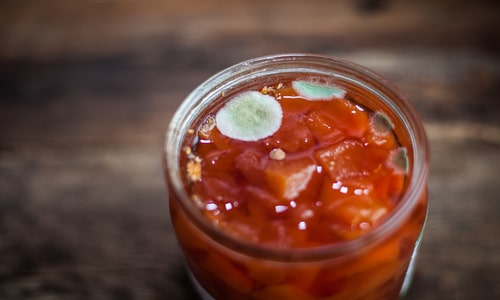Whether you make your own or buy it from the store, it’s horrible to see mold (or mould), on your fruity jam. You’re not sure what could have caused this, and you certainly have plenty of other questions. Can you still eat the jam? How do you keep the jam from getting moldy?
This guide to mold on jam will answer your most burning questions, including what makes jam moldy, what type of mold affects jam, and what can happen to you if you ingest moldy jam. Make sure you keep reading!
Scraping mold off the surface of jam does not make the jam underneath safe to eat. Spores spread by disturbing the mold can spread into new areas of the jar, making it inedible. If mold is found in jam (even in small quantities), the safest option is to throw the jar away.

Why has your jam begun to grow mold?
If you frequently fill your home with fresh produce, it’s no surprise that fruit can become moldy. It reasons to assume then that jam–which is made from fruit–can also develop mould.
Indeed, it can!
While making jam preserves the fruits, if you store your jam in poor conditions such as a bright sunny spot, it doesn’t matter much whether it’s homemade or store-bought. It will soon go bad.
Not screwing on the lid tightly enough, or leaving the jar open for too long during the jam-making process can also contribute to mold, as you’re allowing more time for mold spores to find their way into the jar.
Jam contains less water than whole fruits, usually because boiling the jam causes the water to evaporate. However, the overall moist texture of jam still appeals to mold, and when mold spores come into contact with moisture inside the jam jar, you’ve got a recipe for fungi in your jelly.
Another prime ingredient in jam–sugar, can halt microorganisms in most circumstances but not all. After all, jam is up to 60 percent sugar.
Even still, mould can find a way to ruin your fruity jar of jam before you ever get to really enjoy it.
What kinds of mold grow on jam, and what do they look like?
When jam has gone moldy, it’s typically impossible to miss it. The mold that will grow on the surface features large, fluffy, splotchy circular spores that spread over the top of the jam.
The mold might appear white, gray, or even very pale green.
The same kind of mould that often appears on produce, such as Aspergillus, or Penicillium can also be found growing on both purchased and homemade jams.
Less commonly, molds such as Colletotrichum, Aureobasidium, Tricothecium, Cladosporium, Rhizopus, Botrytis, and Alternaria might grow on produce and thus jam.
How to prevent mold growth on jam (jelly in the US)
Once you lose one jar of jam to mold, you’ll want to go out of your way to prevent it from happening again. Fortunately, you needn’t use very extreme measures to ensure your jam stays fresh and edible for longer.
It’s all about storage. Without further ado, let’s delve into some strategies you can use to prevent mold from forming on the jam.
Store the Jam in a Dry, Dark, Cool Environment
Mould loves humid, damp places. When you deprive the mold of that kind of environment, it’s much less likely to spread in a jar of jam.
The place where you keep the jam should be dry, dark, and cool. If you haven’t opened store-bought jam yet, you can stash the fruit preserves in a pantry or cabinet until you’re ready to use it.
There, the jam should keep for upwards of a year, but always check and abide by the expiration date printed on the jar or the label.
Once you open the jam, you shouldn’t continue to store it in a pantry or kitchen shelf. Instead, move the jam to the refrigerator.
Since the light of your fridge can give off heat, make sure the jam sits a good distance away from the fridge light. Avoid pushing the jar too far to the back of the fridge, as the working components there can also contribute warmth.
Although you might have room for the jam on the fridge doors, try not to keep the fruit preserves there if you can help it. Each time you open the fridge, the contents on the doors are exposed to changing temperatures.
That could encourage spoilage and molding of the jam.
Use an Airtight Lid
Store-bought jams come with a seal and a lid, but if you’re making jam yourself, you get to choose the lid. If the lid is anything but airtight, that allows heat, moisture, and light to get into the jar.
As we mentioned, this can accelerate the spoilage of the jam and possibly cause mold infestation.
Put an airtight lid on the jar and close it securely each time you open the jar to get some jam.
Only Use Sterilized Jars for Jam
Here’s another tip for fruit canners: sterilize your jars!
It’s not enough to wash them out with hot water and soap. After you do that, you should turn on the faucet hot, rinse the jars again, and then bake them for a few minutes in the oven.
You’ll kill off pathogens like bacteria and mould from the jar so you can safely pour in your freshly-made jam.
Is it still safe to eat moldy jam?
We mentioned before that it’s hard to miss mold on jam, but that’s usually on the surface. If the mould reaches deeper into the jar, you might not realize until it’s too late that you’ve ingested moldy jam.
The texture of the jam will certainly give it away. The jam might have also had a funky smell or a rancid or earthy taste.
You spit most of it out, but you’re sure you swallowed some. What will happen?
If you only consume a small amount of moldy jam, more than likely, nothing will come of it. However, if you eat enough, you will experience symptoms such as nausea, diarrhea, and vomiting.
Unless we’re talking about healthy molds (and in the case of mold on jam, we aren’t), you’re not supposed to eat mold. You’ll have food poisoning-like symptoms until you expel the moldy jam from your system.
If a few days have passed and you’re not getting better or your condition worsens, you need to see a doctor.
That also applies if you consumed mold and you have a mold allergy. Since you could experience a life-threatening allergic reaction known as anaphylaxis, you need immediate medical attention.
Can you scoop mold off jam?
Jam lovers might recommend simply scraping the top layer of mould off the jam with a spoon to get rid of the fungus. Maybe you even throw away a few inches of the jam, but not the whole thing.
Just because you can’t see mold deeper into the jam doesn’t mean it’s not there.
Mold could contain mycotoxins, a toxic byproduct of the fungal spreads that cause mold. These metabolites can make you very sick!
We’re not saying that moldy jam contains mycotoxins for sure, but it might. Some jam jars with mold that only appears on the surface have been proven to contain mycotoxins.
That should be a good enough reason to not chance it.
As much as it might pain you to do so if you made the jam yourself, you’re much better off throwing the jar away and starting over.
This way, you can enjoy and share your jam with the peace of mind that you’re not getting yourself or anyone else you love sick.
Can you make jam with moldy fruit?
You had bought some produce to make jam, and you’re sad to say the fruit spoiled before you got to it. Since you’ll boil the fruit anyway, can you still use the good bits to make your classic homemade jam recipe?
It’s not advisable! The fruit right now could cause illness and canning and preserving it will not change that fact.
On top of that, you have to think about how the jam will taste. Using low-quality fruits leads to low-quality jam. You’ll have notes of muskiness and earthiness in your jam that no one will be clambering to eat seconds of.
Instead, you should can your produce at the peak of ripeness or shortly thereafter. It’s fine if the fruit looks wilted, but it should have no traces of mold.
Conclusion
Mold on jam isn’t something you can simply scrape off or ignore. Eating mouldy jam can make you very sick and removing only the surface-level mold doesn’t account for what might be deeper into the jar.
To prevent mouldy jam in the future, always use an airtight container and keep your jam in a cool, dry, dark environment!

